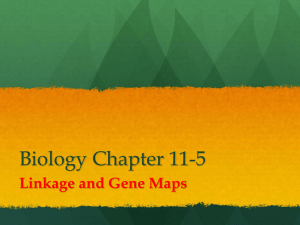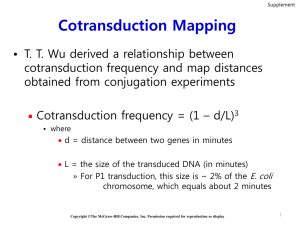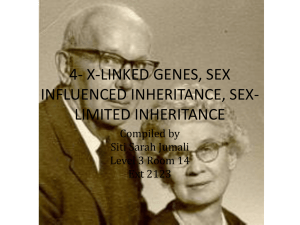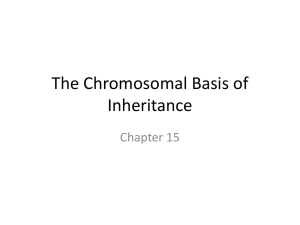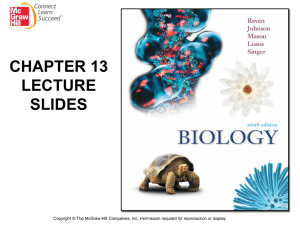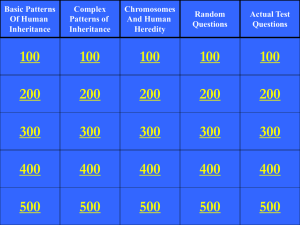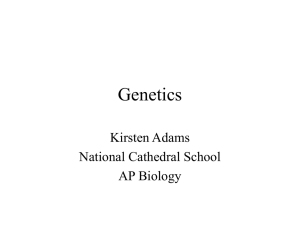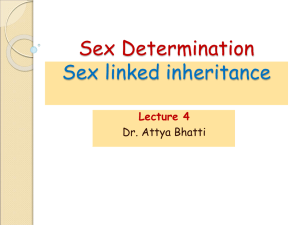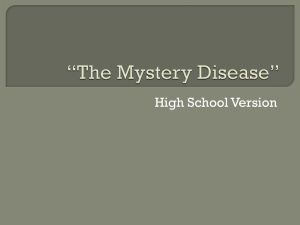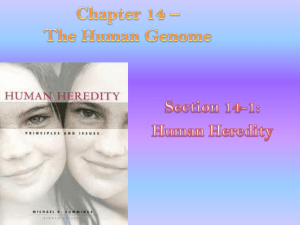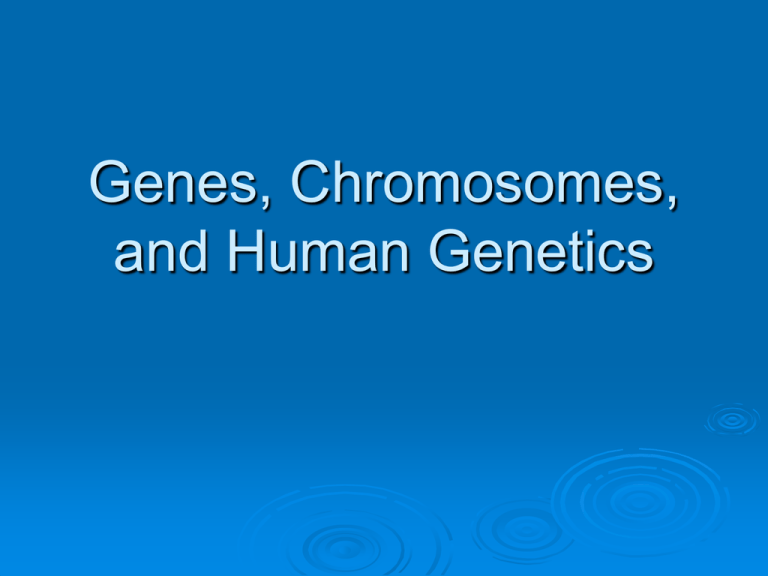
Genes, Chromosomes,
and Human Genetics
Genetic Linkage and
Recombination
The
principles of linkage and
recombination were determined with
Drosophila
Recombination
frequency can be used to
map chromosomes
Widely
separated linked genes assort
independently
Chromosomes
Genes
Sequences of nucleotides in DNA
Arranged linearly in chromosomes
Linked Genes
Genes
carried on the same chromosome
Linked during transmission from parent to
offspring
Inherited like single genes
Recombination can break linkage
Drosophila melanogaster
Fruit
fly
Model organism for animal genetics
Compared to Mendel’s peas
Used to test linkage and recombination
Gene Symbolism
Normal
alleles (wild-type)
Usually most common allele
Designated by “+” symbol
Usually dominant
Wild-type
+ = red eyes
+ = normal wings
Mutant
pr = purple
vg = vestigial wings
Genetic Recombination
Alleles
linked on same chromosome
exchange segments between homologous
chromosomes
Exchanges
occur while homologous
chromosomes pair during prophase I of
meiosis
Evidence for Gene Linkage
Linked genes
Genes
that are close together on the same
chromosome
Belong to the same linkage group
Linkage and Recombination
Linkage;
genes are inherited together
Crossing over produces recombination –
breaks up the association of genes that
are linked
Notation for linkage
AABB
X aabb
Recombination Frequency
Amount
of recombination between two
genes reflects the distance between them
The
greater the distance, the greater the
recombination frequency
Greater chance of crossover between genes
Recombination Frequency
Mapping of Genes
Where
is the gene is located on a
chromosome?
Linkage maps –
• A chromosome map; abstract based on
recombinant frequencies
Physical maps –
• Mapping the positions of cloned genomic
fragments
Linkage Maps
First
genetic map
Alfred Sturtevant in the lab of Thomas Hunt
Morgan
Observed that some pairs of genes do not
segregate randomly according to Mendel’s
principle of independent segregation
Proposed genes were located on the same
chromosome
Variation in the strength of linkage determined
how genes were positioned on the
chromosome
Chromosome Maps
Recombination
frequencies used to
determine relative locations on a
chromosome
Linkage map for genes a, b, and c:
Map: Drosophila Chromosome
Predicting the outcomes of
crosses with linked genes
Determining proportions of the
types of offspring requires
knowing the RF
RF = 16%
Gene mapping with RFs
Genetic
maps
Calculated by RFs
Measured in map units or centimorgans (cM)
RF can not exceed 50%, at 50% cannot
distinguish between genes on the same or
different chromosomes
Double crossovers – underestimate distance
Recombination Occurs Often
Widely
separated
linked genes often
recombine
Seem to assort
independently
Detected by
testing linkage to
genes between
them
Sex-Linked Genes
In
both humans and fruit flies, females are
XX, males are XY
Human
sex determination depends on the
Y chromosome
Sex-Linked Genes
Sex-linked
genes were first discovered in
Drosophila
Sex-linked
genes in humans are inherited
as they are in Drosophila
Inactivation
of one X chromosome evens
out gene effects in mammalian females
Sex Chromosomes
Sex
chromosomes determine gender
X and Y chromosomes in many species
XX: female
XY: male
Other
chromosomes are called
autosomes
Sex Determination in Humans
Human Sex Chromosomes
Human
Large (2,350 genes)
Many X-linked genes are nonsexual traits
Human
X chromosome
Y chromosome
Small (few genes)
Very few match genes on X chromosome
Contains SRY gene
• Regulates expression of genes that trigger male
development
Conclusions
At
least one copy of X is required for
human development
Male-determining gene is on the Y; a
single copy produces a male regardless of
the number of X’s
Absence of Y is female
Genes affecting fertility are on the X and Y
>X’s produces physical and mental
disabilities
Sex determination in humans
Sex
reversed individuals
XX males and XY females
Clues
that there is a gene on the Y
that determines maleness
Proof that SRY is the
male-determining gene
Experiment in mice
SRY gene
When
mouse sry was injected into
the genome of a XX zygote, the
transgenic female mice developed
as males (sterile)
Function of SRY
DNA binding
protein
transcription factor
Initiates a sex switch –
Acts on genes in the undifferentiated gonad,
transforming it into a testis
Once the testis has developed testosterone is
produced for male secondary sex
characteristics
If no SRY, the gonad develops into an ovary
Androgen Insensitivity
If
the androgen receptor (AR) is deleted or
null in function then testosterone can not
act and no maleness results
Results from a mutation in the AR
Evolution of the Y
BioInteractive's Animation
Chromosome
Console: Y
Hey!
Females have two
X’s and males only have
one!
Females are superior?
Dosage Compensation
X-inactivation
Mary Lyon
Barr Body
Dosage Compensation
X-inactivation
XXY males have a Barr body
XO females have none
Barr body is the inactivated X
Dosage Compensation
X-inactivation
In human females an X
chromosome is inactivated in
each cell on about the 12th day
of embryonic life
Dosage Compensation
X-inactivation
X-inactivation is random in a
given cell
Heterozygous females show
mosaicism at the cellular level
for X-linked traits
How is the X
chromosome
inactivated?
How is the X
chromosome
inactivated?
X inactivation specific transcript
(Xist) gene
X-inactivation center (XIC)
Gene
for XIST
Encodes an XIST RNA which is
expressed solely from the inactive
X-chromosome
Coats the inactive X and is involved
in gene silencing
Several genes remain active (PAR
and others)
Calico Cats
Heterozygote
female (no male calico cats)
Barr Body
Tightly
coiled condensed X chromosome
Attached
Copied
inactive
to side of nucleus
during mitosis but always remains
Sex Linkage
Female
(XX): 2 copies of X-linked alleles
Male
(XY): 1 copy of X-linked alleles
Only
males have Y-linked alleles
Sex Linkage
Males
have only one X chromosome
One copy of a recessive allele results in
expression of the trait
Females
have two X chromosomes
Heterozygote: recessive allele hidden
(carrier)
Homozygote recessive: trait expressed
Eye Color Phenotypes in
Drosophila
Normal
wild-type: red eye color
Mutant: white eye color
Evidence for Sex-Linked Genes
Human Sex-Linked Genes
Pedigree
chart show genotypes and
phenotypes in a family’s past generations
X-linked
recessive traits more common in
males
Red-green color blindness
Hemophilia: defective blood clotting protein
Inheritance of Hemophilia
In
descendents of Queen Victoria of
England
Color Blindness in
Humans
Try this problem
a.
b.
c.
d.
Red-green color blindness is X-linked recessive.
A woman with normal color vision has a father
who is color-blind. The woman has a child with
a man with normal color vision. Which
phenotype is NOT expected?
color-blind female
color-blind male
noncolor-blind female
noncolor-blind male
Chromosomal Alterations That
Affect Inheritance
Most
common chromosomal alterations:
deletions, duplications, translocations, and
inversions
Number
change
of entire chromosomes may also
Chromosomal Alterations
Deletion: broken
segment lost from
chromosome
Duplication:
broken segment
inserted into
homologous
chromosome
Chromosomal Alterations
Translocation:
broken segment
attached to
nonhomologous
chromosome
Inversion: broken
segment reattached
in reversed
orientation
c. Reciprocal translocation
One chromosome
Nonhomologous chromosome
Reciprocal translocation
Fig. 13-11c, p. 266
Nondisjunction
Failure
of homologous pair separation
during Meiosis I
Nondisjunction
Failure
of chromatid separation during
Meiosis II
b.
Nondisjunction
Extra
chromosome
(n + 1)
Missing
chromosome
(n – 1)
Normal
(n)
Normal
(n)
Meiosis I
Meiosis II
Gametes
Nondisjunction during the second meiotic division produces two normal
gametes, one gamete with an extra chromosome and one gamete with a
missing chromosome.
Fig. 13-12b, p. 267
Changes in Chromosome
Number
Euploids
Normal number of chromosomes
Aneuploids
Extra or missing chromosomes
Polyploids
Extra sets of chromosomes (triploids,
tetraploids)
Spindle fails during mitosis
Aneuploids
Abnormalities
usually prevent embryo
development
Exception
in humans is Down syndrome
Three copies of chromosome 21 (trisomy 21)
Physical and learning difficulties
Frequency of nondisjunction increases as
women age
Down Syndrome
a.
1
2
3
6
7
8
13
14
15
19
20
9
4
5
10
11
12
16
17
18
21
22
23
Fig. 13-13a, p. 268
Incidence of Down syndrome
per 1000 births
b.
Mother’s age
Fig. 13-13b, p. 268
Aneuploidy of Sex
Chromosomes
Aneuploidy of Sex
Chromosomes
Human Genetics and Genetic
Counseling
In
autosomal recessive inheritance,
heterozygotes are carriers and
homozygous recessives are affected by
the trait
In
autosomal dominant inheritance, only
homozygous recessives are unaffected
Human Genetics and Genetic
Counseling
Males
are more likely to be affected by Xlinked recessive traits
Human
genetic disorders can be
predicted, and many can be treated
Modes of Inheritance
Autosomal
recessive inheritance
Autosomal
dominant inheritance
X-linked
recessive inheritance
Pedigree Analysis I
Pictorial representation of a family
history
Autosomal Recessive
Inheritance
Males
or females carry a recessive allele
on an autosome
Heterozygote
Carrier
No symptoms
Homozygote
recessive
Shows symptoms of trait
Autosomal recessive traits
Appear
In equal frequency in both sexes
Only when a person inherits two alleles for the
trait (one from each parent)
To skip generations (Heterozygotes
unaffected)
Ex.
Tay Sachs
Tay-Sachs disease
Autosomal Recessive
Inheritance
Cystic Fibrosis
Autosomal Dominant
Inheritance
Dominant
gene is carried on an autosome
Homozygote
Show symptoms of the trait
Homozygote
dominant or heterozygote
Normal
recessive
Autosomal dominant traits
Appear
In equal frequency in both sexes
Both sexes can transmit the trait
Does not skip generations unless acquired as
a new mutation
Ex.
Familial hypercholesterolemia
OMIM - HYPERCHOLESTEROLEMIA,
AUTOSOMAL DOMINANT
Autosomal Dominant
Inheritance
X-Linked Recessive Inheritance
Recessive
allele carried on X chromosome
Males
Recessive allele on X chromosome
Show symptoms
Females
Heterozygous carriers, no symptoms
Homozygous, show symptoms
X-linked recessive traits
Appear
more frequently in males
Passed from unaffected female to males
Skips generations
Ex.
Hemophilia A
Hemophilia A
X-Linked Recessive Inheritance
X-linked dominant traits
Appear
more frequently in females
Affected men pass the trait to all of their
daughters and none of their sons
Do not skip generations
Ex.
Hypophosphatemia
OMIM - HYPOPHOSPHATEMIA, XLINKED
Y-linked traits
Appear
Only males are affected
Affected men pass the trait to all of their sons
Do not skip generations
Ex.
Hairy ears
OMIM - HAIRY EARS, Y-LINKED
Genetic Counseling
Identification
of parental genotypes
Construction of family pedigrees
Prenatal diagnosis
Allows
prospective parents to reach an
informed decision about having a child or
continuing a pregnancy
Genetic Counseling Techniques
Prenatal diagnosis tests cells for mutant alleles
or chromosomal alterations
Cells obtained from:
Embryo
Amniotic fluid around embryo (amniocentesis)
Placenta (chorionic villus sampling)
Postnatal genetic screening
Biochemical and molecular tests
Prenatal genetic testing
Ultrasonography
Aminocentesis
– chorionic villus sampling
Karyotype
Maternal blood tests
PGD
CVS
Postnatal genetic testing
Newborn
screening, ex. PKU
Heterozygote screening, ex. Tay Sachs
Presymptomatic testing, ex. Huntington
Interaction between
Sex and Heredity
Cytoplasmic inheritance
Characteristics
encoded by genes in the
cytoplasm
Cytoplasmic organelles inherited from the
egg
Extensive phenotypic variation – no
mechanism to ensure proper segregation
Ex. Mitochondrial genes
Matrilineal inheritance
Russian Revolution
July
16, 1918 a firing squad executed the
tsar, his family, and attendants
Skeletal remains found in 1979
Are the skeletal remains actually
Nicholas II and his family?
Evidence:
Younger brother’s Grand Duke Georgij femur
and tibia
Blood-stained hankie from Nicholas II
Hair clippings from Nicholas II
Discrepancy in the number of
skeletons
Tsar,
his wife, 5 children, 3 servants and
physician
9 skeletons were found – how to explain
the discrepancy?
Nuclear DNA
Nuclear
DNA from the skeletons
established that the skeletons were a
family group
The DNA matched a father and three
daughters
How to prove the skeletons
were those of the
royal family?
Prince Philip’s DNA
Scientists
used Prince Philip’s
mitochondrial DNA to prove that the
skeletons were the remains of Alexandra
and her three daughters
Why mitochondrial DNA?
To establish identity of Nicholas II
To
establish the identity of Nicholas II
scientists needed living relatives – why?
Relatives
– direct female descendent of the
tsar’s sister
James – descends from a line that is
connected to Nicholas II through his
grandmother
Xenia
Not a perfect match
Xenia
= James but does not match
Nicholas II
T at position 16,169
Nicholas there is a mixture of C and T
How can this be?
Nicholas II other brother Georgij
Exhumation
of Nicholas II other brother
Georgij had an examination of his
mitochondrial DNA also contained the
heteroplasmy confirming the remains were
that of Nicholas II
Nontraditional Patterns of
Inheritance
Cytoplasmic
inheritance follows the
pattern of inheritance of mitochondria or
chloroplasts
In
genomic imprinting, the allele inherited
from one of the parents is expressed while
the other allele is silent
Cytoplasmic Inheritance
Genes
carried on DNA in mitochondria or
chloroplasts
Cytoplasmic
inheritance follows the
maternal line
Zygote’s cytoplasm originates from egg cell
Cytoplasmic Inheritance
Mutant
alleles in organelle DNA
Mendelian inheritance not followed (no
segregation by meiosis)
Uniparental inheritance from female
Human Mutations in
Mitochondrial Genes
Genomic Imprinting
Expression
of an allele is determined by
the parent that contributed it
Only one allele (from either father or mother)
is expressed
Other
allele is turned off (silenced)
Often, result of methylation of region adjacent
to gene responsible for trait

